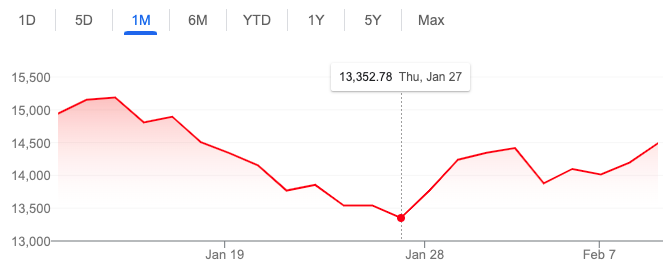The past two years have been horrible for the world as a whole, but in many ways have been transformational (in a good way) for those of us fortunate enough to be involved in the tech industry. After a few months of economy-wide panic in 2020, many major tech companies have benefited from lockdowns and the shift to remote work and seen their values soar as a result.
Today, the pandemic is (hopefully) slowing down, and the financial winds are changing for tech companies. In this post, I’ll look at how public tech companies have surged (and suffered) so far, and what this means for software developers.

Since mid-2020, juggernauts like Amazon, Netflix and Facebook have been able to capitalize on the huge shifts in daily life that were required when Covid hit. In fact, even though I’m not a fan of many of their business and employment practices, I think it’s fair to say that Amazon accomplished the most impressive logistical feat – and some of the most impressive growth – of any company in the world in response to the pandemic. They’ve actually managed to make home delivery even faster than it was before, and they employ a lot more people than they did before the pandemic – with the huge caveat that their warehouse workers deserve much better treatment than they’re getting today. (Another side note is that Amazon Web Services, which as web developers we all know and use every day, apparently subsidizes the money-losing e-commerce side of the company that actually delivers stuff to your front door.)
As established stars soared during the pandemic, so did upstarts like Peloton and Zoom, both of whom had relatively small products that suddenly became front-and-center in the lives of home-office workers. (Disclosure: I bought a Peloton bike during the pandemic, and yet still somehow have a “sedentary coder” belly.)
Today, we all have our fingers crossed that the pandemic is coming to a close, and that we won’t see another round of closures or another case surge any time soon. At the same time, many of these publicly traded companies are reporting their fourth-quarter earnings, and it seems like the Covid tech boom is coming to an end.
Here’s a quick look at the Nasdaq, which includes a lot of tech companies, and which suffered a series of sharp losses at the end of January as earnings reports rolled in.

Netflix says they’re going to struggle to find more subscribers – because just about every American who might want Netflix already has it. This is a good problem to have, except when you are a publicly traded company whose investors (somewhat irrationally) want to see infinite growth forever.
Same goes for Facebook (ahem, I mean Meta), which is predicting a significant slowdown due to new privacy settings on iPhones and the rapid exodus of everyone who values their mental health.
And Peloton, which has already had more than its fair share of very unfortunate ads and negative publicity, is losing its CEO and laying off 2,800 employees as its customers go back to the gym IRL.
This all adds up to the end of the Covid-fueled boom for public tech companies. Life is getting back to normal (at least a little), and we just don’t need to consume quite as much Netflix and DoorDash as we used to.
If you own stock in these companies, that means a downturn, at least for now. But what about those of us who own and work for small-scale tech companies, like WordPress agencies and plugin development shops?
The good news is that some trends are likely here to stay. After the first few months of the pandemic, my agency saw a significant uptick in requests for e-commerce and web-presence upgrades, as small and medium businesses realized that pretty much all their growth needed to happen online for the foreseeable future. Our revenue and growth have been solid for the two years since. While I think platforms like Shopify will eventually suffer a similar effect to what’s happening to Netflix (that is, everyone who needs an e-commerce site already has one), I also think that individual developers and small agencies will have plenty of work to do on the sites that aren’t purely DIY.
Additionally, the pandemic has inspired (or pushed) a lot of people to start small, independent businesses, which are usually a perfect client for developers looking to build $2,000-$5,000 web sites, do lots of SEO, and help less-tech-savvy business owners build their presence online. Those types of projects are likely to stick around and continue to grow for years, as people who were previously working for big companies reconsider their lifestyles and strike out on their own to start small businesses. This was my most common type of client as a young freelancer, and I suspect the surge in new small businesses will help freelance designers and developers for years to come.
My agency also lost a number of clients during the pandemic who ran travel- or event-related businesses, and now we’re seeing them come back to life as the pandemic recedes. That’s another opportunity for growth – and the growth in the travel/entertainment sector probably won’t displace the many other companies who also want to expand their web presence. We might just end up with a bigger total number of projects, which would be great for everyone.
One area where we may see a downturn is in venture-backed startups. Because interest rates are likely to go up soon to combat inflation, venture capitalists will probably become tighter with their cash in the near future. While we’ve done a couple big venture-backed startup sites in the past six months, it’s not an area that I’m pursuing for future growth. The interest-rate hike might also affect institutions like universities or hospitals, which tend to rely heavily on endowments that may be affected by the overall financial market. City and state governments, though, are looking good – their budgets weren’t hurt by Covid as much as they expected, which means many of them have plenty to spend on new initiatives as more services move online.
So, if I were writing a business plan for 2022, it’d start with something like this: Small, independent clients are our growth opportunity. Large, institutional clients are likely to tighten their belts as inflation and interest rates go up, which means fewer big-ticket clients, but still lots of opportunities for an ambitious agency to pursue.


